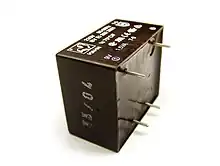
In electronics, potting is a process of filling a complete electronic assembly with a solid or gelatinous compound for high voltage assemblies by excluding gaseous phenomena such as corona discharge, for resistance to shock and vibration, and for the exclusion of water, moisture, or corrosive agents. When such materials are used only on the components, it is referred to as encapsulation.
Thermosetting plastics or silicone rubber gels are often used, though epoxy resins are also very common. When epoxy resins are used, low chloride grades are usually specified.[1] Many sites recommend using a potting product to protect sensitive electronic components from impact, vibration, and loose wires.[2]
In the potting process, an electronic assembly is placed inside a mold (i.e. the "pot"[3]) which is then filled with an insulating liquid compound that hardens, permanently protecting the assembly. The mold may be part of the finished article and may provide shielding or heat dissipating functions in addition to acting as a mold. When the mold is removed the potted assembly is described as cast.[4]
As an alternative, many circuit board assembly houses coat assemblies with a layer of transparent conformal coating rather than potting.[5] Conformal coating gives most of the benefits of potting, and is lighter and easier to inspect, test, and repair. Conformal coatings can be applied as liquid or condensed from a vapor phase.
When potting a circuit board that uses surface-mount technology, low glass transition temperature (Tg) potting compounds such as polyurethane or silicone may be used. High Tg potting compounds may break solder bonds through solder fatigue by hardening at a higher temperature because the coating then shrinks as a rigid solid over a larger part of the temperature range, thus developing greater force.[6]
See also
References
- ↑ Dr. H. Panda (8 July 2016). Epoxy Resins Technology Handbook (Manufacturing Process, Synthesis, Epoxy Resin Adhesives and Epoxy Coatings): Manufacturing Process of Epoxy Resins, Manufacturing Process of Epoxy Resins, Making of Epoxy Resins, Process for Manufacture of Epoxy Resins, Epoxy Resin Manufacturing Plant, Epoxy Resin Plant, Epoxy Resin Production Plant, Epoxy Resin Manufacture, Epoxy Resin Manufacturing Unit, Epoxy Resin Production, Epoxy Resins in Industry, Manufacture of Epoxy Resins. ASIA PACIFIC BUSINESS PRESS Inc. p. 419. ISBN 978-81-7833-174-4.
- ↑ "Hackaday". Hackaday. 2012-06-04. Retrieved 2018-09-04.
- ↑ "What's the Difference Between Potting and Conformal Coating?". 2016-01-22. Retrieved 2019-02-05.
- ↑ Haleh Ardebili, Michael Pecht, Encapsulation Technologies for Electronic Applications, William Andrew, 2009 ISBN 0815519702, page 36
- ↑ "Design Practices for Low-Power External Oscillators" (PDF). Retrieved 2018-09-04.
- ↑ "Potting Solutions Potting Hints". Pottingsolutions.com. 2015-03-28. Retrieved 2018-09-04.
External links
- polyurethane potting at Curlie
- silicone potting at Curlie
- epoxy resin potting at Curlie
- adhesive potting compounds at Curlie